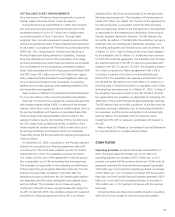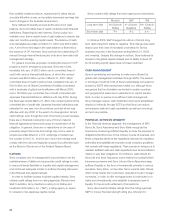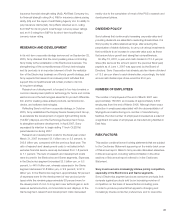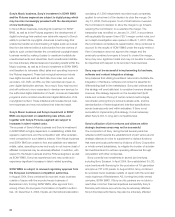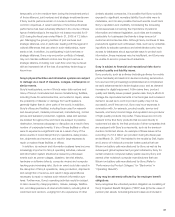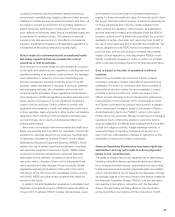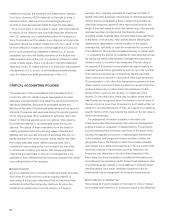Sony 2007 Annual Report Download - page 83
Download and view the complete annual report
Please find page 83 of the 2007 Sony annual report below. You can navigate through the pages in the report by either clicking on the pages listed below, or by using the keyword search tool below to find specific information within the annual report.
80
flow volatility mentioned above, repayments for debts whose
due date fall within a year, and possible downward earnings risk
due to changes in the business environment.
Sony defines its liquidity sources as the amount of cash
balance, and committed lines of credit contracted with financial
institutions. Regarding its cash balance, Sony’s policy is to
maintain more than a certain level of cash balance to absorb any
daily and monthly working capital needs. The balance of cash
and marketable securities on March 31, 2007 was 525.9 billion
yen. A short-term shortage in the cash balance is financed by
the issuance of CP. However, Sony controls the outstanding CP
amount through internal limits as part of its short-term debt risk
management strategy.
For general corporate purposes, including the support of CP
programs and for emergency purposes, Sony has a total,
translated into yen, of 689.3 billion yen in committed lines of
credit with various financial institutions, of which the unused
amount was 684.9 billion yen as of March 31, 2007. Major
committed lines of credit include a total, translated into yen, of
505.4 billion yen of Global Commitment Facilities contracted
with a syndicate of global banks effective until March 2009,
and a 150 billion yen committed line of credit contracted with
Japanese financial institutions, effective until July 2009. During
the fiscal year ended March 31, 2007, the contract period of the
committed line of credit with Japanese financial institutions was
extended for one year, from the previous contract which was
effective until July 2008. In the event of a downgrade in Sony’s
credit ratings, even though the cost of borrowing could increase,
there are no financial covenants in any of Sony’s material
financial agreements that would cause an acceleration of the
obligation. In general, there are no restrictions on the uses of
proceeds except that some borrowings may not be used to
acquire securities listed on a U.S. exchange or traded over-
the-counter in the U.S., and the use of such borrowings must
comply with the rules and regulations issued by authorities such
as the Board of Governors of the Federal Reserve Board.
RATINGS
Sony considers one of management’s top priorities to be the
maintainenance of stable and appropriate credit ratings in order
to ensure financial flexibility for liquidity and capital management
and continued adequate access to sufficient funding resources
in the financial and capital markets.
In order to facilitate access to global capital markets, Sony
obtains credit ratings from two rating agencies, Moody’s and
S&P. In addition, Sony maintains a rating from Rating and
Investment Information, Inc. (“R&I”), a rating agency in Japan,
for access to the Japanese capital market.
Sony’s current debt ratings from each agency are noted below:
Moody’s S&P R&I
Long-term debt A2 (Outlook: A– (Outlook: AA– (Outlook:
Stable) Negative) Stable)
Short-term debt P-1 A-2 a-1+
In October 2006, S&P changed its outlook of Sony’s long-
term debt rating from stable to negative. This change was made
based upon their view of increased uncertainty for Sony’s
business recovery in the fiscal year ending March 31, 2008,
and onwards. Despite this change in outlook, Sony believes its
access to the global capital markets and its ability to issue CP
for its working capital needs have not been restricted.
CASH MANAGEMENT
Sony is centralizing and working to make more efficient its
global cash management activities through SGTS. The excess
or shortage of cash at most of Sony’s subsidiaries is invested or
funded by SGTS after having been netted out, although Sony
recognizes that fund transfers are limited in certain countries
and geographical areas due to restrictions on capital transac-
tions. In order to pursue more efficient cash management,
Sony manages uneven cash distribution among its subsidiaries
directly or indirectly through SGTS so that Sony can reduce
unnecessary cash and cash equivalents as well as borrowings
as much as possible.
FINANCIAL SERVICES SEGMENT
In the Financial Services segment, the management of SFH,
Sony Life, Sony Assurance and Sony Bank recognize the
importance of securing sufficient liquidity to cover the payment of
obligations that they incur in the ordinary course of business, and
these companies abide by the regulations imposed by regulatory
authorities and establish and operate under company guidelines
that comply with these regulations. Their purpose in doing so is to
maintain sufficient cash and cash equivalents and secure sufficient
means to pay their obligations. For instance, cash inflows for
Sony Life and Sony Assurance come mainly from policyholders’
insurance premiums and Sony Life and Sony Assurance keep
sufficient liquidity in the form of investments primarily in various
securities. Sony Bank, on the other hand, uses its cash inflows,
which come mainly from customers’ deposits in local or foreign
currencies, in order to offer mortgage loans to individuals or to
make bond investments, and establish a necessary level of
liquidity for the smooth settlement of transactions.
Sony Life currently obtains ratings from five rating agencies:
S&P for insurer financial strength rating (A+), Moody’s for









